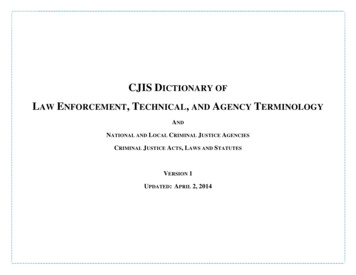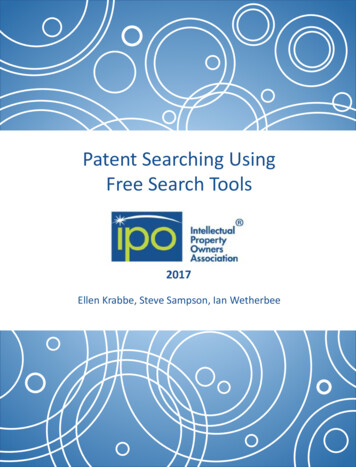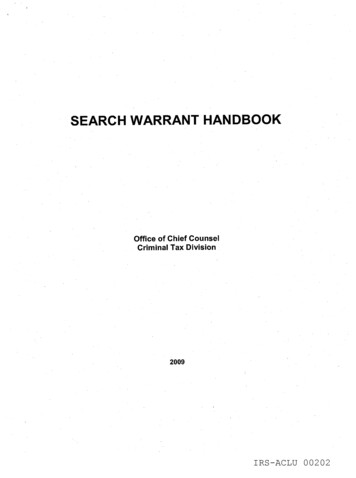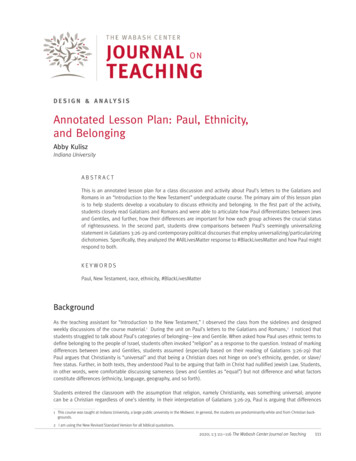
Transcription
The Complete SearchWarrant, AnnotatedConsolidated EditionByAlbert M. RosenblattNEW YORK STATEUNIFIED COURTSYSTEMNovember 2004
Copyright 2005New York State Unified Court SystemAll rights reserved
ABOUT THE AUTHORA graduate of the University of Pennsylvania andHarvard Law School, Albert M. Rosenblatt is aJudge on the New York Court of Appeals andformer Chief Administrative Judge of New YorkState. Before that, he had been DutchessCounty’s District Attorney and then served on theCounty Court, Supreme Court, and AppellateDivision, Second Department. He has written ona variety of legal and popular topics.He and his wife Julia, a writer and former VassarCollege professor, live in Dutchess County. Theirdaughter, Betsy, is an attorney in California,specializing in intellectual property.
PREFACE"Where is your warrant?"This question has been asked countless times, butrarely with more drama than in "The Disappearance of LadyFrances Carfax," a Sherlock Holmes adventure. The villain, abogus preacher named Holy Peters, was unlawfully secretinghis victim and Holmes demanded entry. On his side, the greatdetective had only justice and a revolver. Where was thewarrant? Holmes half drew the revolver from his pocket andreplied, "This will have to serve till a better one comes,"Holmes explained.The approach worked well for Sherlock Holmes but willnot do for American law enforcement officials. A revolver canbe as effective as a warrant, and may even produce promptercompliance, but given the exclusionary rule, it would beuneconomical to trade in this modest volume for a Colt .45.This is the most recent incarnation of a work that I wroteas a prosecutor in 1973. Much has happened over theensuing 31 years. The cases (not to mention the writer) havegrown older but the inventory has been replenished severaltimes over, and so what began as a 44 page work has grownto 120 pages. In 1973 the piece was published by the NewYork State District Attorneys' Association, under the able aegisof Richard L. Friedman. I updated the work for a few years,with the help of the Bureau of Prosecution and DefenseServices, expertly directed by Bill Dowling and Michael Gross.1997 saw a revised edition, and so the work stood until thispast year.In preparing it, I relied not only on the abundant body ofdecisional law but on a number of publications, particularly theexcellent treatises by Judge William C. Donnino (New YorkCourt of Appeals on Criminal Law), Barry Kamin's book onNew York Search and Seizure, and Wayne R. LaFave'sSearch and Seizure volumes. In addition, and with their eagleeyes, Judge Donnino and Judge Steven W. Fisher read themanuscript and made a number of valuable suggestions thatI have included in the text.At a judicial training event at our Pace Law Schoolfacility, Judge Juanita Bing Newton generously commentediii
that the work was still on its feet (although a bit wobbly withage, I submit), and that her office would publish a new version.She offered to have her staff collate the earlier editions andtheir supplements. This took not only astute computers but theenergy and creativity of Justin Barry, who designed theprogram for the table of contents and more, Ellen Magid whodiligently helped stitch together all the previous editions, andJanine Zanin, who aided immeasurably in updating the versionimmediately preceding this one. I thank them all for theirvalued contributions, along with Lisa DellAquila, and JustinLong for their helpful comments.ALBERT M. ROSENBLATTiv
TABLE OF CONTENTSPAGEI.II.III.Affidavit for Search WarrantSearch WarrantAnnotated Footnotes (by Footnote Number)1.Proper Court to Issue Warrant2.Authorizing Search of More Than One Person, Place, or Vehicle3.Preciseness of Description of Premises -- Misdescription4.Vehicle Defined.5.Certainty of Identification of Known Target6.Search of Person Wherever Found7.Search of Any Person "Thereat or Therein"8.Applicant's Use of Fictitious Name9.Public Servant Defined10. Probable Cause (Reasonable Cause)11. Anticipatory Search Warrant; Controlled Delivery12. Matching Descriptions13. Description of Property To Be Seized14. Stolen Property – Basis For Conclusion15a-c Particularity of Description; Overbreadth16. Mere Evidence – Contraband – Plain View17. Requirement For Factual Recitation of Specific Acts of Crime18. Police Deponent – Direct, Knowledgeable Observations –Reliability19. Manner of Acquisition of Proof – Use or Exploitation of IllegalEvidence – Independent Source20. Staleness21. Specificity of Location22. Reliability of Confidential Informant23. Basis of Confidential Informant’s Knowledge24. Verification of Confidential Informant’s 6495255566164v
PAGE25.26.27.IV.viInformant’s Declarations Against Penal InterestSworn Testimony or Production of Confidential InformantFacts Not Included in Affidavits But Presented When Warrant IsIssued – Method of Recording28. Citizen-Informant – Crime Victim29. Establishing Reliability30. Prior Record of Suspect31. Nighttime (Anytime) Search Warrants32. No-Knock Warrants33. Directive For Search and Seizure34. Searching For Suspect in Third Person’s Premises35. Subscribing and Swearing to the Application36. Jurat37. Name of Court38. Person or Agency to Whom Search Warrant is Issued; Failure toAddress Warrant to Particular Police Agency39. Authorization and Directive40. Description of Property41. Identification of Place, Premises, or Person42. Authorization to Search Any Person "Thereat or Therein"43. Execution of Warrant: Where and When44. Return of Warrant45. Dating the Warrant46. Signing the WarrantDiscussion Items1.The Value of a Search Warrant2.Burden of Proof3.Administrative Searches4.Disclosure of Informant5.A Search Is Measured by the Proof in Existence at Its Inception6.Searching in Defendant's Absence7.Searching Parolees8.Motions to Suppress9.Post-Issuance: Controverting the Veracity of the 989909194989899100102
5.26.27.28.29.30.31.Arrest of Suspect in a Residence: Warrant RequirementUse of Subpoena to Secure EvidenceSecuring the Scene for a Search WarrantOral Search Warrant (A/K/A Telephonic Search Warrants)Information Supplied by ChildrenBeepers (A/K/A Tracking Devices, Transponders, Beacons)DogsThermal Surveillance DevicesSearch Warrants for Corporeal Evidence (Blood, Scrapings,Teeth, Etc.)Search Warrants for Video-Type SurveillanceSearch Warrants for Computer ContentsPen Registers / Trap and Trace DevicesTo Whom is the Search Warrant Addressable: Who MayExecute It: Addressability: CPL 690.25 (1)Out of State WarrantsReissuanceStandingClosed ContainersDisposition of Seized PropertySearch Warrants By EmailSealing Search Warrants"Sneak and Peek" Search WarrantsSearch Warrants for 5117118118119120120121121123vii
This page intentionally left blank.viii
AFFIDAVIT FOR SEARCH WARRANTSUPREME COURT (COUNTY COURT)1(CRIMINAL COURT OF THE CITY OF NEW YORK)(DISTRICT COURT), (CITY COURT)(TOWN COURT), (VILLAGE COURT)(VILLAGE) (TOWN) (CITY) OFCOUNTY OFSTATE OF NEW YORKHon., issuing Judge (Justice)IN THE MATTER OF THE APPLICATION OF(NAME)of the(Agency)for asearch warrant to search the following premises.2(Describe the structure and it components, e.g.: #2F; the ground floor of a two familydwelling; a barn, a garage, etc.)3located at (give address, as specifically as possible):in the (city) (town) (village) of1
County of, State of New York.IF APPLICABLE:and the following vehicle (aircraft, boat, etc.)4IF APPLICABLE:and the person(s) of 5wherever (he) (she) (they) be found.6IF APPLICABLE:and pursuant to CPL 690.15 (2), the search of any person found in the designatedpremises or vehicle72
STATE OF NEW YORKCOUNTY OF, being duly sworn, deposes and says that:I am the applicant herein,8 a public servant9 of the kind specified in CPL Section§690.05(1), my title beingThere is reasonable cause10 to believe that certain property, hereinafter described, (maybe found at) (will within the next [hours] [days] be arriving at)11 the followingpremises12and (if applicable) upon the person ofand (if applicable) in the vehicle ofbeing (describe vehicle as explicitly as possible)The property referred to sought to be seized is:13(a) stolen14 property, consisting of15a (identify as explicitly as possible):3
(b) property, unlawfully possessed,15b to wit (identify as explicitly as possible):(c) property that has been used (and/or) is possessed for the purpose of being usedto commit an offense (or to conceal the commission of an offense15c), to wit (identifyproperty as explicitly as possible):(d) property constituting evidence of crime,16 tending to demonstrate that an offensewas committed, to wit (describe the property constituting evidence and how itdemonstrates the commission of an offense):(e) property tending to demonstrate that (NAME)4
participated in the commission of the offense of, to wit17 (describe the property and how itconnects the target with the offense):If applicable (FOR USE IN ARREST WARRANT CASES): There is reasonable cause tobelieve that(name of person) for whomthe attached arrest warrant has been issued (CPL 690.05 [2] [b]) may be found at.In support of your deponent’s assertion as to the existence of reasonable cause, thefollowing facts are offered,18 based on your deponent's personal knowledge19 as attestedto by your deponent (and by the supporting affidavits of others who have personalknowledge).Set forth, as explicitly as possible, the supporting facts, usingdates, places, names, and the source(s) of the deponent'spersonal knowledge. This paragraph is to be used in caseswhere the facts are being supplied by the applicant-deponent,supplemented, if necessary, by the affidavits of others whohave personal knowledge. (CPL 690.35. [3] [c])5
IF RELYING ON A CONFIDENTIAL INFORMANT ALLEGE AS FOLLOWSThe source of my information is the following:I have received information from a reliable confidential informant, that (specify the facts,using names, dates,20 and places21 to the extent feasible, spelling out the information beingfurnished by the confidential informant):6
The informant is known to me to be reliable because:22(Establish history)The information conveyed to me by the informant is based on the informant’s personalknowledge and direct observations, to wit23 (relate what the informant claims to haveactually seen or heard, and what the informant asserts based on first-hand knowledge andobservations. If the informant is not speaking from first-hand knowledge, the applicantmust set forth the basis for the informant's knowledge and assertions, along with reasonsto satisfy the court that the informant's assertions are reliable – in addition to the informanthimself/herself being reliable. See footnote 22):7
IF APPROPRIATEMoreover, members of this department, including your deponent, have independentlyconfirmed the confidential informant’s assertions in the following respect, and to thefollowing degree:248
IF APPROPRIATEFurthermore, the informant’s assertions are reliable because they represent declarationsagainst penal interest.25IF THE INFORMANT IS W ILLING, THE FOLLOWINGSHOULD BE DONE, AND ALLEGED:The confidential informant, though undisclosed by name, is now being produced before thiscourt,26 in order that the informant may, under oath, furnish the court with evidence insupport of this search warrant. The informant is amenable to any questioning the courtdeems necessary for purposes of issuing this warrant. I request that questioning berecorded under the court’s authority, in the court’s own notes, or by use of a stenographer27or tape recorder, with the record to be sealed by the court, until further order of a courthaving jurisdiction to order disclosure.IF FACTS ARE FURNISHED BY A “CITIZEN” W HO W ANTSANONYMITY (AS OPPOSED TO A RELIABLE CONFIDENTIAL“POLICE” INFORMANT) ALLEGE AS FOLLOWS:I have received information from an individual who is not a regular police informant but anordinary citizen who, owing to fear of involvement or reprisal, wishes to remain anonymous(or, if not, name the person). The individual told me the following (relate what the citizen9
claims to have actually seen or heard, and what the citizen asserts, based on first handknowledge and observations28):This individual is known to me to be reliable, because:2910
IF APPROPRIATEMoreover, members of this department, including your deponent, have independentlyconfirmed the veracity of the individual’s assertions in the following respects, and to thefollowing degree:IF APPROPRIATEAdditional grounds exist establishing reasonable cause, namely, the prior criminalrecord of the individual (who) (whose premises) (whose car) is (are) to be searched. Theprior criminal record consists of the following:30Based on CPL 690.35 (4) (a), I request a determination pursuant to CPL Section 690.40(2)that the search warrant contain an authorization for execution at any time of the day ornight,31 on the ground that there is reasonable cause to believe that:(a) It cannot be executed between 6:00 A.M. and 9:00 P.M. because (set forth the11
reasons, based on facts)AND/OR(b) The property sought will be removed or destroyed if not seized forthwith,because (set forth reasons, based on facts)(c) [For use in arrest warrant cases (CPL 690.05 [2] [b])]: The person is likely to fleeor commit another crime or may endanger the safety of the executing police officeror another person if not seized forthwith or between the hours of 9:00 P.M. and6:00A.M.Based on CPL 690.35 (4) (b), I request a determination pursuant to CPL Section 690.40(2)that the executing officer(s) be authorized to enter the premises to be searched withoutgiving notice of authority or purpose,32 on the ground that there is reasonable cause to12
believe that(a) the property sought may be easily and quickly destroyed or disposed of (set forthfacts in support of this belief)and/or(b) such notice may endanger the life or safety of the executing police officer oranother person (set forth facts in support of this belief):Or(c) [For use in arrest warrant cases (CPL 690.05 [2] [b])]: The person sought is likelyto commit another felony or may endanger the life or safety of the executing officeror another person13
Wherefore, your deponent requests that the court issue a search warrant directing asearch for and seizure of33 the following property or (if searching for a person pursuant toCPL 690.05 [2] [b]), the following person34Dated:, New York35(Deponent)Approved by:DISTRICT ATTORNEY’S OFFICE (not necessary but advisable)Sworn to before me thisday of, 2036Judge (Justice) of theCounty of14Court,, State of New York.
SEARCH WARRANT1.SUPREME COURT (COUNTY COURT)37(CRIMINAL COURT OF THE CITY OF NEW YORK)(DISTRICT COURT), (CITY COURT)(TOWN COURT), (VILLAGE COURT)(VILLAGE) (TOWN) (CITY) OFCOUNTY OFSTATE OF NEW YORKHon.2., issuing Judge (Justice)To any police officer of theDepartment383.You are hereby authorized and directed39 to search for and to seize the followingproperty40 :or (if the search warrant is based on an arrest warrant pursuant to CPL 690.05 [2][b]), the following person:4 (a) If applicable: (if inapplicable, strike the following paragraph)You are authorized and directed to search the following premises41 :15
4 (b) If applicable: (if inapplicable, strike the following paragraph)You are authorized and directed to search the following named or describedperson(s):4 (c) If applicable: (if inapplicable, strike the following paragraph)You are authorized and directed to search the following vehicle:4 (d) If applicable: (if inapplicable, strike the following paragraph)This court having authorized the search of the designated premises, further directs,pursuant to CPL §690.15 (2), the search of any person present thereat or therein.425.Pursuant to CPL 690.45 (6), this warrant must be executed between 6:00 A.M. and9:00 P.M. or,6.For anytime/nighttime warrantIf sought and supported factually, strike the above 6:00 A.M. to 9:00 P.M. clause,and replace it with the following: This court hereby specially determines thatadequate grounds exist for authorizing the search to be made at any time of the dayor night, and pursuant to CPL 690.45 (6) the court so directs.16
7.For no-knock warrantIf sought and supported factually, include the following clause for no-knock warrant;if not, strike it. This court hereby specially determines that adequate grounds existand pursuant to CPL 690.45 (7) authorizes any executing police officer to enter thepremises to be searched without giving notice of the officer’s authority and purpose.8.This warrant must be executed not more than 10 days43 after the date of itsissuance and any property seized shall be returned and delivered to the courtwithout unnecessary delay.449.(If appropriate): Having heard and recorded the testimony of the confidentialinformant, the court orders the record of that testimony sealed until further courtorder.Dated:45, N.Y.46Judge (Justice) of theCourt,County, New York17
This page intentionally left blank.18
FOOTNOTE 1PROPER COURT TO ISSUE WARRANTThe application must contain the name of the court (CPL 690.35 [3] [a]). Searchwarrants are issuable by local criminal courts (CPL 690.35 [2] [a]). A superior court (asupreme court or a county court) may issue a search warrant, but when those courts doso they sit as "local criminal courts" (CPL 690.20 [1]; CPL 10.10 [1], [2]). Under CPL690.20 (1), a search warrant of the Supreme Court, County Court, District Court, or theNew York City Criminal Court may be executed anywhere in the State.The language authorizing "a local criminal court" to issue a search warrant comportswith CPL 10.10 (3) (f) and (g), which contemplates supreme court justices or county courtjudges sitting as local criminal courts. The New York City criminal court is a local criminalcourt (CPL 10.10 [3] [b]), as is any district court (CPL 10.10 [3] [a]). Thus, in People vCarson (216 AD2d 965 [4th Dept 1995]), the appellate division upheld a search warrantissued by the county court sitting as a local criminal court even though the warrant did notsay so. In People v Johnson (165 Misc 2d 227 [Rochester City Ct 1995]), the courtinvalidated a search warrant (issued by a county judge) because it did not indicate that thecourt was sitting as a local criminal court. This decision was rejected, correctly, in Peoplev Rhoades (166 Misc 2d 979 [Sup Ct, Monroe County 1995]).City courts, town courts and village courts are local criminal courts (CPL 10.10 [3])and hence are authorized to issue search warrants, but the warrants may be executedpursuant to their terms “only in the county of issuance or an adjoining county” (CPL 690.20[2]). There is a bit of history here. In 1976, the Court of Appeals held that a town court or19
justice court may not issue a search warrant unless it has geographic (though notnecessarily trial) jurisdiction (see e.g. People v Hickey, 40 NY2d 761, 762-63 [1976] [theTown Justice of Orchard Park lacked jurisdiction to issue a search warrant for narcoticsdirected at an apartment in the city of Buffalo since the offense was not committed inOrchard Park, the geographic jurisdiction of the Town Justice]). By contrast, see Peoplev Johnson (44 AD2d 451 [1st Dept 1974], affd 36 NY2d 864 [1975]) in which the Court heldthat a district court may issue a search warrant to be executed anywhere in the State (CPL690.20[1]) and that a warrant issued by a Suffolk County district court judge authorizing asearch in Bronx County for the proceeds of a Suffolk County jewelry store robbery waslawful, notwithstanding that it uncovered evidence of a crime in Bronx County (criminalpossession of stolen property). See also People v Herrara (112 AD2d 315 [2d Dept 1985])in which a search warrant, executed in Nassau County, was issued by a Suffolk CountyDistrict Court. The affidavits did not contain a specific allegation that crimes had beencommitted in Suffolk County. The seizure was upheld on the ground that it could beinferred that crimes were allegedly committed in Suffolk County because the policeapplicant and assistant district attorney were both Suffolk officials.In the aftermath of Hickey, the legislature amended CPL 690.35 in 1992 to broadenthe choice of courts empowered to issue search warrants (L 1992, ch 815, 816). Theapplication may now be made to any judge having geographic jurisdiction or "preliminaryjurisdiction" over the underlying offense (CPL 690.35 [2] [a]; see also CPL 1.20 [25][defining preliminary jurisdiction] and CPL 100.55).Further, by way of alternative and given the road map of CPL 690.35 (2) (a) (i), if atown court has such preliminary or geographical jurisdiction, but is not available, the20
warrant may be issued by the local criminal court judge in:(1) any village within such town, or(2) any adjoining town or village embraced in whole or in part by suchadjoining town, or(4) a city of the same county.Thus, if a crime is committed, for example, in Westchester County and a search isjustified for a location in the Town of Tonowanda in Erie County, a Tonowanda town courtwould be authorized to issue the search warrant (see generally Preiser, PracticeCommentaries, McKinney's Cons Laws of NY, Book 11A, CPL 690.35, at 379).Accordingly, the City Court of Newburgh (Orange County) had jurisdiction to issue awarrant to search the defendant's premises in the Town of New Windsor (Orange County)where the underlying illegal drug activity described in the warrant application occurred inthe Town of New Windsor (People v Chrysler, 287 AD2d 7 [2d Dept 2001], citing Peoplev Fishman, 40 NY2d 858 [1976]; see also Preiser, Practice Commentaries, McKinney'sCons Laws of NY, Book 11A, CPL 690.35, at 379, 2004 Supp Pamph, at 131).In People v Cobb (5 AD3d 790 [2d Dept 2004]), the court held that a Pleasant Valley(Dutchess County) Town Justice had authority to issue a search warrant for a search in theTown of LaGrange (Dutchess County) in a case in which the application alleged that thedefendant committed class B felonies in the Town of LaGrange. The Court rejected thedefendant’s contention that the issuing court lacked preliminary jurisdiction, holding thatCPL 100.55 (6) gives every town court within a county preliminary jurisdiction over a felonycommitted in any town in the county. The Court went on to hold that the Town Justice hadauthority to issue the search warrant even though he was not within his geographic21
jurisdiction at the time (citing United States v Strother, 578 F2d 397 [DC Cir 1978]).CPL 690.10 (3) and (4) were amended in 1994 to make it clear that New York courtsmay issue search warrants for property relevant to out-of-state crimes.A search warrant application must contain the name of the court (CPL 690.35 [3][a]), but in People v Pizzuto (101 AD2d 1024 [4th Dept 1984]), the court stated that thefailure of judge to fill in the space at the top of the search warrant, intended for thedesignation of the court, was a technical and non-fatal omission where it was elsewhereidentified (see also People v Smythe, 172 AD2d 1028 [4th Dept 1991]).An issuing judge was not disqualified from acting as suppression motion judge(People v McCann, 85 NY2d 951 [1995]; cf. Pierce v Delameter, 1 NY 3 [1847]).After a judge declined to sign a search warrant, the applicant was free to go toanother judge. The first judge's refusal was not the law of the case (People v Bilsky, 95NY2d 172 [2000]).See generally Annotation, Requirement, Under Federal Constitution, That PersonIssuing Warrant for Arrest or Search Be Neutral and Detached Magistrate – Supreme CourtCases, 32 L Ed 2d 970 (2004).FOOTNOTE 2AUTHORIZING SEARCH OF MORE THAN ONE PERSON,PLACE, OR VEHICLEA court may issue a search warrant for a designated premises, vehicle, or person(CPL 690.05 [2] [a]; 690.15 [1]). Accordingly, a search warrant may cover more than one22
entity, provided there is reasonable cause for each (People v Tambe, 71 NY2d 492 [1988];People v Vanderpool, 217 AD2d 716 [3d Dept 1995]; see also Annotation, Propriety andLegality of Issuing Only One Search Warrant to Search More Than One Place or PremisesOccupied by Same Person, 31 ALR2d 864).In People v De Sivo (194 AD2d 935 [3d Dept 1993]), the facts justified a searchwarrant for defendant's trailer, outbuildings, and vehicle. A search of two residences wasupheld in People v Alaxanian (76 AD2d 187 [3d Dept 1980], affd sub nom People v Lanier,54 NY2d 725 [1981]). A search warrant authorizing the search of defendant's housejustified a search of his car (trunk) which was parked at the premises (see People vPowers, 173 AD2d 886 [3d Dept 1991]; United States v Ross, 456 US 798 [1982]).In People v Cahill (2 NY3d 14 [2003]), a search of defendant’s shed was justifiedbecause the warrant was explicitly identified as an addendum to a warrant issued threedays earlier which permitted searches in the defendant’s home or “within any unattachedgarage or storage shed.”A search warrant that did not specifically authorize the search of an automobilecould not be used to search a car that was driven into the driveway of the house specifiedin the warrant (see People v Dumper, 28 NY2d 296, 299 [1971]; but see United States vCombs, 468 F2d 1390 [6th Cir 1972], cert denied 411 US 948 [1973] [valid seizure of a gunfrom defendant's car, under a warrant for his house, on the theory that the car was "on thepremises" situated close enough to the house to be within its curtilage]).Curtilage: This term is defined (according to Webster) in People v Reynolds (71NY2d 552 [1988]) as “a yard, a garden, enclosure, or field near or belonging to a building.”In areas outside the curtilage, an owner of open fields enjoys no fourth amendment23
protection (see Oliver v United States, 466 US 170 [1984]), but state constitutional law willrequire a search warrant where the owner posts signs signifying an expectation of privacy(see People v Scott, 79 NY2d 474 [1992]).Courts have allowed some flexibility in sustaining searches executed within the"curtilage" of the premises when the search warrant does not name the curtilage area asan area to be searched (see generally 2 LaFave, Search and Seizure, § 4.10 [a] [3d ed];United States v Dunn, 480 US 294 [1987]). Curtilage searches were upheld as within thesearch warrant in United States v Earls (42 F3d 1321 [10th Cir 1994] [outbuildings]; UnitedStates v Griffin, 827 F2d 1108 [7th Cir 1987] [tool shed]; People v Davis, 146 AD2d 942[3d Dept 1989] [tool shed]; United States v Frazin, 780 F2d 1461 [9th Cir 1986] [garage]).But there are limits. A search warrant for a first floor apartment in a 20-unit building did notauthorize a search of the basement (see United States v King, 227 F3d 732 [6th Cir 2000]).These issues may sometimes be averted by specific language in the application andwarrant particularizing the outbuildings (see e.g. State v Pelletier, 673 A2d 1327 [Me 1996];see generally Annotation, Search Warrant: Sufficiency of Description of Apartment orRoom to be Searched in Multi-Occupancy Structure, 11 ALR3d 1330).Severability: When reasonable cause exists with respect to one premises orperson, but not another, the warrants, as severable, have been sustained as to thereasonable cause segment (People v Hansen, 38 NY2d 17 [1975]; see also People vBrown, 96 NY2d 80 [2001]; People v Robinson, 68 NY2d 541 [1986]; People v Scavone,59 AD2d 62 [3d Dept 1977]; People v Hines, 62 AD2d 1067 [3d Dept 1978]; People vNyemczycki, 67 AD2d 442 [2d Dept 1979]. See generally Annotation, Propriety in StateProsecution of Severance of Partially Valid Search Warrant, 32 ALR 4th 378, § 6;24
Annotation, Propriety in Federal Prosecution of Severance of Partially Valid SearchWarrant and Limitation of Suppression to Items Seized Under Invalid Portions of Warrant,69 A.LR Fed 522 (2003).FOOTNOTE 3PRECISENESS OF DESCRIPTION OF PREMISES -- MISDESCRIPTIONThe premises named in the search warrant should be particularly identified. Forexample, a search warrant directing a search of a “building,” was struck down as overbroadwhen the police knew or should have known that it contained more than one apartment(see People v Rainey, 14 NY2d 35 [1964]; People v Henley, 135 AD2d 1136 [4th Dept1987]; People v Sprague, 47 AD2d 510 [3d Dept 1975] [wrong building]; People v Sciacca,45 NY2d 122 [1978] [evidence of crime seized from van must be suppressed where thevan was in garage when searched since search warrant authorized only search of van butnot garage]).By contrast, see People v Teicher (52 NY2d 638 [1981] [upholding execution of asearch warrant authorizing videotaping of a dentist's sexual abuse of patients, althoughwarrant stated that camera was to be placed in one examining room, and was actuallyplaced in another]), People v Horton (32 AD2d 707 [3d Dept 1969] [search valid though itencompassed room not found in warrant; defendant rented the room, which was adjacentto his apartment, the subject of the search warrant]), and People v Salgado (57 NY2d 662[1982] [erroneous designation of apartment to be searched as number 25J instead ofnumber 25C held immaterial where informant accompanied police to apartment, wasadmitted by occupant, and confirmed that occupant was person referred to in warrant;25
before search was conducted, warrant was amended to state correct designation ofapartment]). See also People v Hammock (182 AD2d 1114 [4th Dept 1992] [no hearingnecessary to deal with alteration of address in search warrant intended to encompassentire premises]).In People v Tramell (152 AD2d 989 [4th Dept 1989]), the Court held that thedescription in the search warrant, when read with the affidavit, sufficiently delineated thearea to be searched, as against defendant's claim of “overbreadth” (see also People v DeLago, 16 NY2
decisional law but on a number of publications, particularly the excellent treatises by Judge William C. Donnino (New York Court of Appeals on Criminal Law), Barry Kamin's book on New York Search and Seizure, and Wayne R. LaFave's Search and Seizure volumes. In addition, and with their eagle eyes, Judge Donnino and Judge Steven W. Fisher read the










